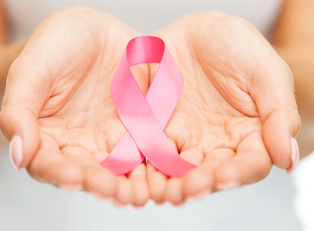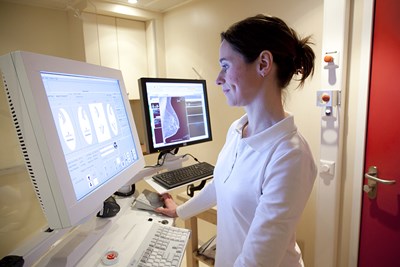When a suspicious site is detected in your breast through a breast self-exam or on a screening mammogram, your doctor may request an ultrasound of the breast tissue. A breast ultrasound is a scan that uses penetrating sound waves that do not affect or damage the tissue and cannot be heard by humans. There is no radiation involved. The breast tissue deflects these waves causing echoes, which a computer uses to paint a picture of what’s going on inside the breast tissue. A mass filled with liquid shows up differently than a solid mass.
The detailed picture generated by the ultrasound is called a “sonogram.” Ultrasounds are helpful when a lump is large enough to be easily felt, and the images can be used to further evaluate the abnormality. A breast ultrasound can provide evidence about whether the lump is a solid mass, a cyst filled with fluid, or a combination of the two. While cysts are typically not cancerous, a solid lump may be a cancerous tumor. Healthcare professionals also use this diagnostic method to help measure the exact size and location of the lump and get a closer look at the surrounding tissue. It cannot determine whether a solid lump is cancerous, nor can it detect calcifications.
If you’re under age 30, your doctor may recommend ultrasound before mammography to evaluate a palpable breast lump (a breast lump that can be felt through the skin). Mammograms can be difficult to interpret in young women because their breasts tend to be dense and full of milk glands. (Older women’s breasts tend to be fattier and are easier to evaluate.) In mammograms, this glandular tissue looks dense and white — much like a cancerous tumor. Some doctors say that locating an abnormality in the midst of dense gland tissue can be like finding a polar bear in a snowstorm. Most breast lumps in young women are benign cysts, or clumps of normal glandular tissue. Doctors also can use ultrasound to guide biopsy needles precisely to suspicious areas in the breast.
Dense breasts have less fatty tissue and more non-fatty tissue compared to breasts that aren't dense. Women with dense breasts can be 6 times more likely to develop cancer. Adding ultrasound to annual mammograms improves breast cancer detection in women with dense breasts. Ultrasound is particularly good at finding small breast cancers that haven’t spread to the lymph nodes yet. But mammograms are still needed because ultrasound alone doesn't detect all types of breast cancers.



